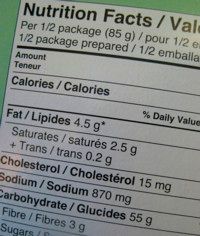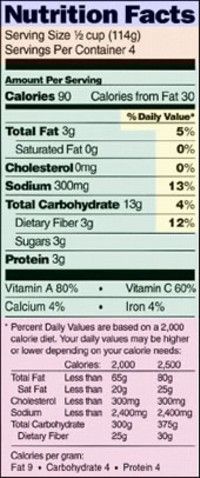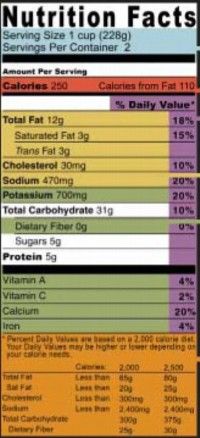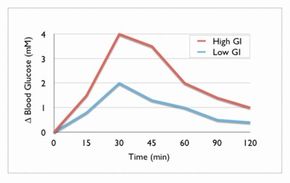 “Learn the answers to common nutritional questions, including food labeling questions.©U.S.D.A.
“Learn the answers to common nutritional questions, including food labeling questions.©U.S.D.A.
Good nutrition is essential to living a long, healthy life. These nutrition questions and answers can help ensure that you and your family enjoy the full health benefits of everyday foods.
Use the information in these nutrition articles to lead the way to smarter, healthier food choices.
Calculating Nutrition in Homemade Foods
How many calories are in a slice of that birthday cake you baked? Is your favorite Sunday dinner a nutritional nightmare? Find out how to calculate nutrition for the foods you prepare at home.
Understanding Food Labels
Food labels have an abundance of information. Get tips on understanding the many terms and abbreviations on a nutrition label.
Understanding the Glycemic Index
The glycemic index has been featured in many popular diet plans. Learn what the glycemic index is and how you can incorporate it into your meal planning.
For more information on nutrition and food labeling, see:
- How Nutrition Works
- Food Labels
- Eating Healthy
- Choosing a Diet Program: Low Glycemic Index Diet //]]]]> ]]>
Calculating Nutrition in Homemade Foods
 “Although homemade foods do not come with a nutritional label, there are several ways to calculate their nutrition.©U.S.D.A.
“Although homemade foods do not come with a nutritional label, there are several ways to calculate their nutrition.©U.S.D.A.
Q. How do I figure out the carbohydrates in homemade bread? I make it from scratch or use my bread machine. My favorites are oatmeal or other whole grains.
A. Short of having your own computer and a nutritional analysis program, there are a couple of ways you can check the carbohydrate count on your homemade bread.
One way is to find a similar bread in the supermarket. Look for ingredients that are closest to the ones in your homemade bread. Then read the nutrition label. If your loaf is of a similar size and has similar ingredients, you’ll have a ballpark figure for the carbohydrate count. Remember: Your homemade bread slices will need to be the same size as the store-bought slices.
You can also look up bread in carbohydrate-counting books. Most books offer a variety of different breads. These books usually are available at your local library, or they can be purchased at bookstores or online.
The surest way to know the carbohydrate count of your bread is to work with a registered dietitian or certified diabetes educator. Chances are that he or she has a nutritional analysis program. By entering your recipe ingredients and amounts, and the number of slices per loaf, you will be able to determine the carbohydrate count per slice. Your registered dietitian can then help you decide just how many slices of that bread should be in your individualized meal plan.
In the meantime, we’ve checked a carbohydrate-counting book for you. A slice of oatmeal bread has 13 grams of carb for 1 starch exchange, while a multi-grain slice has 12 carbs for 1 starch exchange. These are, of course, just estimates.
For more information on nutrition and food labeling, see:
- How Nutrition Works
- Food Labels
- Eating Healthy
- Choosing a Diet Program: Low Glycemic Index Diet
Understanding Food Labels
 “The typical food label has a number of abbreviations and terms that may be unfamiliar to you.©U.S.D.A.
“The typical food label has a number of abbreviations and terms that may be unfamiliar to you.©U.S.D.A.
Q. I’m confused when I read nutrition labels. What do "mg" and "g" mean? Are these in food? Any help would be appreciated.
A. Milligrams (mg) and grams (g) are not in food. They are units of measurement used in the metric system.
Food is composed of protein, carbohydrate (starch), fat, sodium, fiber, and other components, such as vitamins and minerals. Nutritionists analyze food to determine how much of each component is contained in a serving.
On U.S. food labels and in nutritional information included with recipes, protein, carbohydrate, fat, and fiber are measured in grams by weight, abbreviated as "g." Cholesterol and sodium (salt) are measured in milligrams, abbreviated as "mg."
One gram equals .035 of an ounce; 100 grams equals 3.5 ounces; 1,000 milligrams equals 1 gram.
For more information on nutrition and food labeling, see:
- How Nutrition Works
- Food Labels
- Eating Healthy
- Choosing a Diet Program: Low Glycemic Index Diet
Understanding the Glycemic Index
 “The Glycemic Index rates foods based on how they affect blood sugar levels.©Scott Dickinson
“The Glycemic Index rates foods based on how they affect blood sugar levels.©Scott Dickinson
Q. What is the glycemic index? Is it useful in managing diabetes?
A. The Glycemic Index (GI) rates foods based on how they affect blood sugar levels. In the 1980s, researchers began tracking how quickly various foods raise blood sugars. The GI score compares foods to white sugar. (White sugar ranks a GI score of 100.) Many people believe that knowing the GI scores of foodstuffs helps them control blood sugars.
Some foods do raise blood sugars quickly, such as white potatoes. But few people eat potatoes without eating anything else (even potato chips contain fat calories). The food combinations within the entire meal or snack will affect the total blood sugar response.
Fiber content, whether the food is cooked or ripened, the degree of processing, and portion sizes are not factored into the GI. Yet these other factors also influence the glycemic response.
According to the American Diabetes Association, the total amount of carbohydrate consumed is more important than the individual food source. Other influences on blood sugars include exercise, stress, time of day, and overall health.
However, it may be useful to develop a personal Glycemic Index. Certain foods may raise your blood sugars very quickly. In that case, just limit your intake or avoid those foods altogether.
Remember that dietary choices should be made with the guidance of a certified diabetes educator, doctor, or other health professional. The goal of meal planning is to eat a wide variety of foods in portions adequate to maintain good nutrition, as well as proper body weight and blood sugar control.
For more information on nutrition and food labeling, see:
- How Nutrition Works
- Food Labels
- Eating Healthy
- Choosing a Diet Program: Low Glycemic Index Diet














































